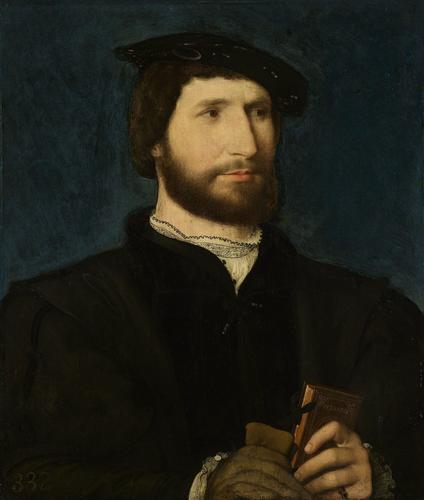Portrait of a Man Holding a Volume of Petrarch c. 1530 - c. 1535
Oil on panel | 38.4 x 33.0 cm (support, canvas/panel/stretcher external) | RCIN 404421
-
The sitter in this arresting portrait remains unidentified. In his ungloved hand he holds a small volume by the celebrated fourteenth-century Italian poet Petrarch, though the inscription ‘Petrarca’ is on the back cover of the volume rather than the front. The laces of the binding are undone, as if the man has just stopped reading the volume. The binding is Venetian and is probably a pocket-sized edition of the Rime, either the 1521 or 1533 Aldine editions which carried the title Il Petrarca. The Petrarch volume suggests the man is cultivated, as it does in the portrait attributed to Parmigianino (1526, private collection) in which the sitter holds a similar small volume of poetry (inscribed ‘FRANC/P’, also on the back cover). The sitter in the Portrait of a Man (Muzeum Narodowe, Poznan), perhaps a copy of a lost original by Jean Clouet, holds his hands and a very similar book in the same way as here.
In the nineteenth century the present work was thought to be a portrait of Claude d’Urfé (1501-58), who owned an important collection of books and manuscripts, including a famous illuminated Triumphs of Petrarch. However, his likeness is recorded in a red chalk drawing in the Musée Condé, Chantilly, and does not match this painting. Petrarch was also of particular importance to Francis I, himself a poet, who read and imitated the Rime and Trionfi. He wanted to portray himself as the new heir of Petrarch, a poet and an Italian prince, who was King of France and had political ambitions in Italy. Several copies of the new Aldine edition of 1533 were sent to the court in that year. In late summer, on his journey to Marseille to celebrate the marriage of the Dauphin to Catherine de Médicis and to meet the Pope, Francis stayed at Avignon, where he discovered the so-called tomb of Laura (Petrarch’s muse) in the convent of St Francis, inspiring him to compose an epitaph and pay homage to Laura.
The technique of painting used here bears resemblances to Leonardo’s method of building up form, and it is possible that Clouet had encountered Leonardo, or the work of his followers, when he was at the French court. Delicate brushstrokes, clearly visible in the paler areas, define forms with great sensitivity, a technique which is very different from Holbein’s precise single outlines. Clouet suggests that skin can be seen through the delicate white shirt at the sitter’s collar, whereas the doublet and gown are modelled with broad dabbed strokes. A large number of portrait drawings by Jean Clouet survive in red or black chalk or a combination of colours with close diagonal hatching, a similar technique to the one he used here in paint. There is a detailed study of the sitter’s head in the Musée Condé, Chantilly - the curve of the sitter’s nose is smoothed to a more flattering and less realistic profile in the painting. The survival of both the preparatory drawing and the painted portrait is a rare occurrence in Jean Clouet’s work.
The painting appears in Pyne's illustrated 'Royal Residences' of 1819, hanging in The Queen's Closet at Kensington Palace (RCIN 922154).
Catalogue entry adapted from The Northern Renaissance. Dürer to Holbein, London 2011Provenance
First recorded in the collection of Charles II, 1666
-
Creator(s)
Acquirer(s)
-
Medium and techniques
Oil on panel
Measurements
38.4 x 33.0 cm (support, canvas/panel/stretcher external)
52.5 x 47.2 x 4.5 cm (frame) (frame, external)
Alternative title(s)
L'Homme au Petrarque
Claude d'Urfé, Seigneur de Châteauneuf, previously identified as









